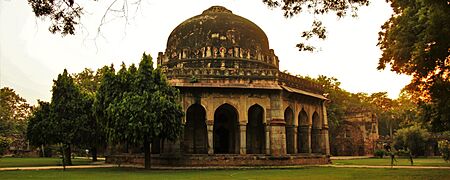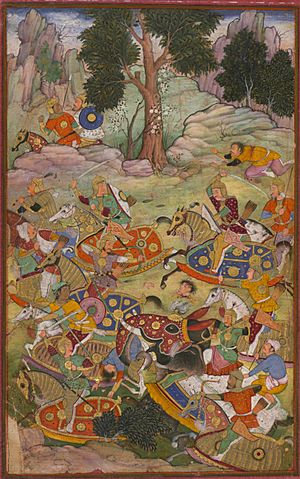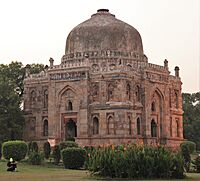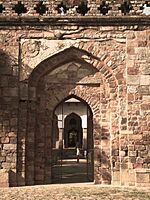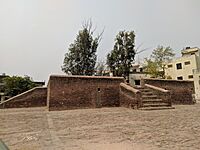Lodi dynasty facts for kids
Quick facts for kids
Lodi
لودی
|
|||||||||||
|---|---|---|---|---|---|---|---|---|---|---|---|
| 1451–1526 | |||||||||||

Map showing the territory under the Lodi dynasty.
|
|||||||||||
| Capital | Delhi | ||||||||||
| Official languages | Hindavi Persian (court, revenue records) |
||||||||||
| Religion | Sunni Islam | ||||||||||
| Government | Monarchy | ||||||||||
| Sultan | |||||||||||
|
• 1451–1489
|
Bahlol Lodi (first) | ||||||||||
|
• 1489–1517
|
Sikander Lodi (2nd) | ||||||||||
|
• 1517–1526
|
Ibrahim Lodi (last) | ||||||||||
| History | |||||||||||
|
• Established
|
1451 | ||||||||||
|
• Disestablished
|
1526 | ||||||||||
|
|||||||||||
The Lodi dynasty was a royal family from Afghanistan that ruled the Sultanate of Delhi from 1451 to 1526. It was the fifth and final ruling family of the Delhi Sultanate. This dynasty was started by Bahlul Khan Lodi after he took over from the Sayyid dynasty.
Contents
Who Was Bahlul Lodi?
After the Sayyid dynasty, the Lodi family, who were of Afghan background, took control of the Sultanate. Bahlul Khan Lodi (ruled 1451–1489) was a strong leader. He was the nephew and son-in-law of Malik Sultan Shah Lodi, who was a governor in Sirhind, Punjab. Bahlul took over as governor after Malik Sultan Shah Lodi.
Bahlul was a powerful chief in Punjab. He was good at uniting different Afghan and Turkish chiefs. He made sure that the local leaders followed his rules. He also brought new energy to the government.
In 1451, the last Sayyid ruler, Alauddin Alam Shah, willingly gave up his throne to Bahlul. So, Bahlul Khan Lodi became the Sultan of Delhi. A very important event during his rule was the conquest of the Jaunpur Sultanate. Bahlul spent much of his time fighting against the Sharqi dynasty of Jaunpur. He eventually took control of it. In 1486, he made his oldest son, Barbak, the ruler of Jaunpur.
Sikandar Lodi's Rule
Sikandar Khan Lodi (ruled 1489–1517) was Bahlul's second son. He became Sultan after his father's death in 1489 and took the name Sikandar Shah.
Sikandar founded the city of Agra in 1504 and built many mosques there. He moved the capital of the Sultanate from Delhi to Agra. He also encouraged trade and business. Sikandar was a talented poet and supported learning. He even ordered medical books written in Sanskrit to be translated into Persian. He made his Pashtun nobles follow stricter rules. This helped make the government stronger and more organized. His biggest success was taking over Bihar from the Sharqis.
Sikandar Lodi was very strict about his religious beliefs. He sometimes ordered the destruction of Hindu temples. He also stopped Muslim women from visiting the tombs of Muslim saints. He banned a yearly procession for a famous Muslim martyr. Sikandar also set up Islamic law courts in many towns.
Ibrahim Lodi: The Last Sultan
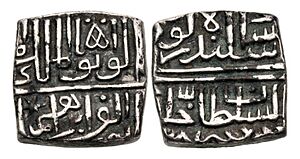
Ibrahim Khan Lodi (ruled 1517–1526) was Sikandar's oldest son. He was the last Lodi Sultan of Delhi. Ibrahim was a good warrior, but he made quick and sometimes unwise decisions. He tried to have complete control as king. However, his methods were too harsh without enough support for the government or military.
Ibrahim faced many rebellions during his rule. He fought against Afghan groups and the Timurid Empire for almost ten years. He died trying to save the Lodi dynasty. Ibrahim was defeated in 1526 at the Battle of Panipat (1526). This battle ended the Lodi dynasty and led to the start of the Mughal Empire in India.
Why the Empire Fell
By the time Ibrahim became Sultan, the Lodi dynasty was weakening. Trade routes were not used as much, and the treasury was running low on money. The Deccan was an important coastal trade route. But by the late 1400s, the supply lines had broken down. This meant goods could not easily travel from the coast to the Lodi empire's inner regions.
The Lodi dynasty could not protect its trade routes. This led to less trade and less money. The empire became weak and faced many internal problems.
To get revenge for insults from Ibrahim, Daulat Khan Lodi, the governor of Lahore, asked Babur, the ruler of Kabul, to invade. Ibrahim Lodi was killed in battle with Babur at the Battle of Panipat (1526). With Ibrahim Lodi's death, the Lodi dynasty ended. This led to the creation of the Mughal Empire in India.
Challenges from Within
Ibrahim faced problems with his own nobles when he became Sultan in 1517. Some Pashtun nobles supported Ibrahim's older brother, Jalaluddin. Jalaluddin even started a rebellion in Jaunpur. Ibrahim gathered his army and defeated his brother by the end of the year. After this, he arrested the nobles who opposed him. He then appointed his own loyal people to important positions. Other Pashtun nobles supported Dariya Khan, the governor of Bihar, against Ibrahim.
Another reason for uprisings against Ibrahim was that he didn't have a clear successor. His own uncle, Alam Khan, even betrayed Ibrahim. Alam Khan supported the Mughal invader Babur.
Rajput Invasions and Rebellions
Rana Sanga, a Rajput leader from Mewar (ruled 1509–1526), expanded his kingdom. He defeated the Lodi king of Delhi. All the Rajput clans recognized him as their main prince. Daulat Khan, the governor of the Punjab region, asked Babur to invade the Lodi kingdom. He wanted revenge on Ibrahim Lodi. Rana Sanga also offered his help to Babur to defeat Ibrahim Lodi.
The Battle of Panipat (1526)
After getting help from Alam Khan and Daulat Khan, Babur gathered his army. When Babur entered the Punjab plains, his allies suggested he get the powerful Janjua Rajputs to join him. This tribe was known for opposing the Delhi throne. Babur met their chiefs, Malik Hast and Raja Sanghar Khan. He reminded them that their ancestors had helped his own ancestor, Emir Timur. Babur helped them defeat their enemies in 1521. This made their alliance strong. Babur then made them generals in his campaigns to conquer Delhi and India.
The new use of guns allowed smaller armies to gain a lot of ground. Babur had survived two revolts himself. He was careful to treat the local people well after victories. He followed local traditions and helped widows and orphans.
Babur wanted Ibrahim's power and land, even though both were Sunni Muslims. Babur and his army of 24,000 men marched to Panipat. They had muskets and cannons. Ibrahim prepared for battle with 100,000 men and 1,000 elephants. However, Ibrahim's army did not have guns. He was at a disadvantage because his soldiers and tactics were old-fashioned. He also faced rivalries within his own army.
Even with more men, Ibrahim had never fought against gunpowder weapons. He did not know how to plan his strategy. Babur quickly took the lead. Ibrahim died on the battlefield in April 1526, along with 20,000 of his men.
The Rise of the Mughals
After Ibrahim's death, Babur declared himself emperor of Ibrahim's lands. He did not place Alam Khan (Ibrahim's uncle) on the throne. Ibrahim's death marked the end of the Lodi dynasty. It led to the start of the Mughal Empire in India. The lands that belonged to the Lodi dynasty became part of the new Mughal Empire. Babur continued to lead military campaigns.
Mahmud Lodi's Resistance
Ibrahim Lodi's brother, Mahmud Lodi, declared himself Sultan. He continued to fight against the Mughal forces. He provided about 4,000 Afghan soldiers to Rana Sanga in the Battle of Khanwa in 1527. After that defeat, Mahmud Lodi fled eastward. He challenged Babur again two years later at the Battle of Ghaghra in 1529.
Religion and Buildings

The Lodi Sultans saw themselves as representatives of the Abbasid Caliphate. This meant they recognized the authority of a united Islamic leadership. They gave money and land to Muslim religious scholars (ulama) and Sufi leaders. They also supported people who claimed to be descendants of Muhammad.
Muslims living under Lodi rule had to pay a religious tax called zakat. Non-Muslims paid a tax called jizya to receive state protection. In some areas, Hindus also had to pay an extra tax for pilgrimages. However, several Hindu officers worked in the Sultanate's government.
Sikandar Lodi, whose mother was Hindu, showed strong Sunni religious views. This was partly for political reasons. He destroyed Hindu temples. He also banned women from visiting the mazars (mausoleums) of Muslim saints. He stopped the yearly procession of a legendary Muslim martyr's spear. Sikandar also set up sharia courts in towns with many Muslim people. These courts allowed judges (qazis) to apply Islamic law to both Muslim and non-Muslim people.
-
The Rajon ki Baoli stepwell was built by Sikandar Lodi in 1516.
See also
- Lodi (Pashtun tribe)
- Lodi Gardens




